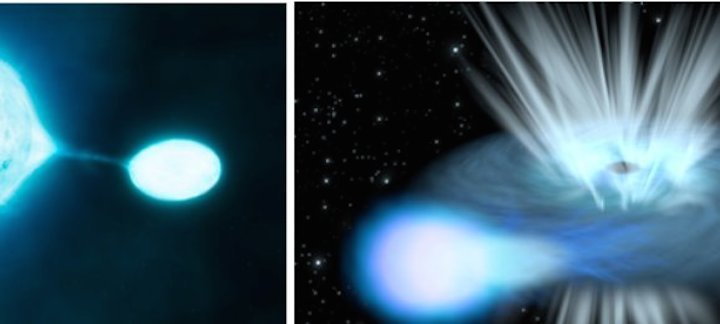2.07.2017
Dutch astronomers find new way to form close double black holes

A team of three Dutch astronomers from the University of Amsterdam and Leiden University found a new way to form two black holes that orbit each other for quite a while and then merge. Their publication with computer simulations has been accepted by the Monthly Notices of the Royal Astronomical Society.
At the beginning of June 2017, it was breaking news for the third time: two merging black holes caused a burst of gravitational waves. Astronomers, though, do not agree on how such double black holes form. One hypothesis is that two black holes form far away from each other, drift slowly towards each other and then start orbiting. The second hypothesis is that two massive stars orbit each other, explode and collapse into two black holes.
Dutch researchers Ed van den Heuvel (University of Amsterdam), Simon Portegies Zwart (Leiden University) and Selma de Mink (University of Amsterdam) now show that this second hypothesis, of two orbiting stars, is more likely than previously expected.
Ed van den Heuvel, who in 1972 was one of the first astronomers to study the evolution of heavy double stars, is the first author of the current article. "If our calculations are correct, double black holes, with a combined mass of fifteen to thirty times that of the sun, arise more often than expected. In our own Milky Way, for example, according to the new calculations such a merging black hole develops once in 100,000 years. Of course, that is still rare for humans, but it's ten times more often than was thought."
Simon Portegies Zwart, who performed the new simulations on 'his' super computer Little Green Machine: "When the heaviest of the two stars collapses into a black hole, there is a stable situation in which the second star can survive for a long time before it forms the second black hole. In the meantime the first black hole sucks in a lot of matter from the second star, and it ejects much of it again. This mass emission causes considerable shrinking of the double star's orbit. So, when the second star collapses into a black hole, a close double star is formed of two black holes that will fuse together later."
Van den Heuvel: "Until now, it was thought that binaries almost always fuse into a single big star and then form one black hole. And that only in extreme cases with double stars in a very wide or a very close orbit would form a double black hole. Now, we show that the conditions need not be so extreme. "
Quelle: ASTRONOMIE NL
